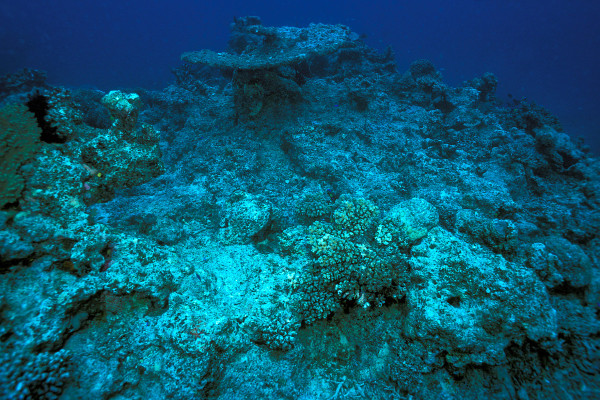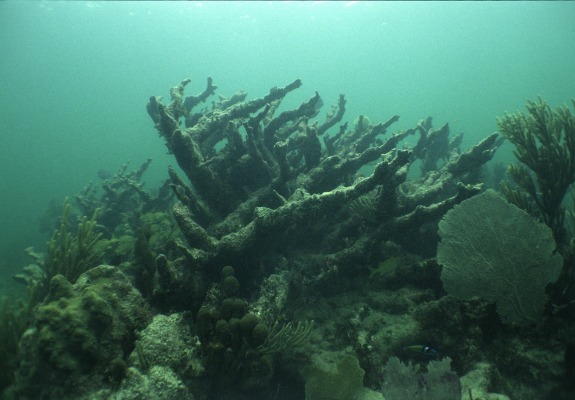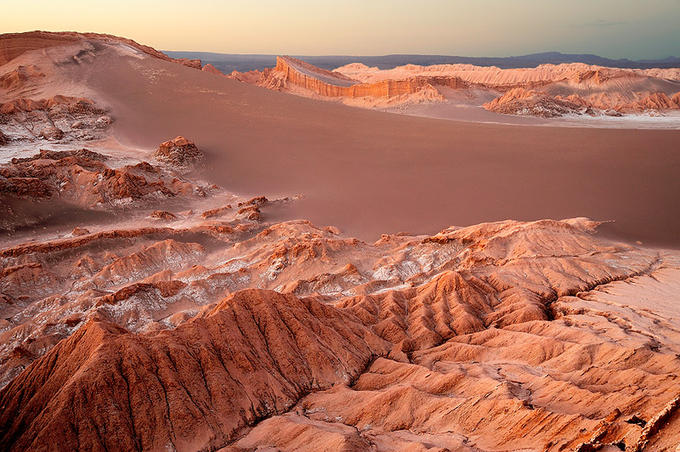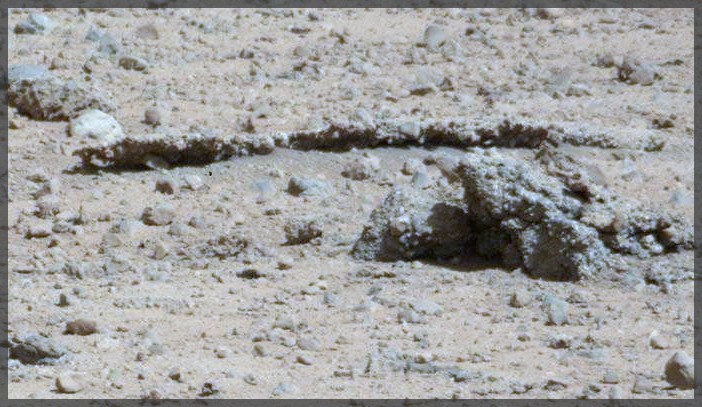It looks like you're using an Ad Blocker.
Please white-list or disable AboveTopSecret.com in your ad-blocking tool.
Thank you.
Some features of ATS will be disabled while you continue to use an ad-blocker.
share:
funbox
jeep3r
funbox
reply to post by jeep3r
lots of little white chunks in that, its not what the robotic arm was imaging in sol 571 was it ?
funBox
White chunks, yep, very interesting ... I don't think it's been imaged by MAHLI up to now, I've also seen these formations with concretions and deposits in a sol 542 image:
NASA/JPL Source Image
Image is white-balanced, also looks very 'marine' in nature ...
I was watching a programme the other day , on underwater lava formations , is that what we are seing in some of these irregular amorphous rocks ? only hit hard with surface erosion after the water disappeared ?
underwater lava is an excellent visual munch
funBox
A lot of these areas do remind me of dead coral reefs and sponges.


Well, I'm not really all that interested in pareidolia. As a kind of intellectual exercise, I'm looking for things in the images that could plausibly
be the fossilized remains of an actual thing that could have existed or evolved at some distant time in a watery environment. Sponge or coral
growths. Shells. That kind of thing. So rather than looking for statues and faces, I'm generally looking for things with unusual (at least to me)
symmetry or possible segmentation, or logarithmic spirals. Something a living creature could make that would be unlikely to occur by another natural
process.
Maybe like this. It doesn't look like anything I know of. It's not pareidolia. But you can see a possible central body topped by antennae or tentacles, perhaps like a large hydra. Could even be a little waste tube at the bottom. It even looks like it came out of a broken open rock, which could be another indication that it's not a weathering artifact.

mars.jpl.nasa.gov...]http://mars.jpl.nasa.gov/msl-raw-images/msss/00572/mcam/0572M L2318003000E1_DXXX.jpg
Could be something. Probably not. Interesting, though.
Maybe like this. It doesn't look like anything I know of. It's not pareidolia. But you can see a possible central body topped by antennae or tentacles, perhaps like a large hydra. Could even be a little waste tube at the bottom. It even looks like it came out of a broken open rock, which could be another indication that it's not a weathering artifact.

mars.jpl.nasa.gov...]http://mars.jpl.nasa.gov/msl-raw-images/msss/00572/mcam/0572M L2318003000E1_DXXX.jpg
Could be something. Probably not. Interesting, though.
edit on 18-3-2014 by Blue Shift because: (no reason given)
reply to post by Char-Lee
yeah and the shiny thing on the rock or next to it ... hard to tell what that is

im,not sure if where the one is you found, at the front ?
funBox
yeah and the shiny thing on the rock or next to it ... hard to tell what that is

im,not sure if where the one is you found, at the front ?
funBox
funbox
reply to post by Char-Lee
yeah and the shiny thing on the rock or next to it ... hard to tell what that is
im,not sure if where the one is you found, at the front ?
funBox
Yes right on the left side of the Reef like area.
Stunning how many shapes are the same as what we are seeing on Mars and the fossil corals and sea life.
Blue Shift
Well, I'm not really all that interested in pareidolia. As a kind of intellectual exercise, I'm looking for things in the images that could plausibly be the fossilized remains of an actual thing that could have existed or evolved at some distant time in a watery environment. Sponge or coral growths. Shells. That kind of thing. So rather than looking for statues and faces, I'm generally looking for things with unusual (at least to me) symmetry or possible segmentation, or logarithmic spirals. Something a living creature could make that would be unlikely to occur by another natural process.
Maybe like this. It doesn't look like anything I know of. It's not pareidolia. But you can see a possible central body topped by antennae or tentacles, perhaps like a large hydra. Could even be a little waste tube at the bottom.
mars.jpl.nasa.gov...]http://mars.jpl.nasa.gov/msl-raw-images/msss/00572/mcam/0572M L2318003000E1_DXXX.jpg
Could be something. Probably not. Interesting, though.
edit on 18-3-2014 by Blue Shift because: (no reason given)
Since I sculpt I end up looking and in three separate areas feel I have found, broken pottery and statues they have been broken nearly beyond recognition, but I believe they are there. I hope someday I will know one way or another. I also look for anything that stands out as pattern beyond the usual rock forms.
How does one prove or disprove pareidolia when we are talking about a planet we cannot even see clearly photos. I think it is just not right to rule things out when it is still unclear what can or can't be or has been in existence on Mars.
Blue Shift
It's not pareidolia.
It can always be pareidolia, but that's a good find.
ArMaP
reply to post by Char-Lee
When exporting images do you add the extension?
No I just saved them and hoped to open them with another program then resave with another extension.
reply to post by Char-Lee
well that's was my initial thoughts on Jeeps rock and many of the other rocks , lava formed underwater, eroded/fedupon by crustacians? and finally weathered , for that off beaten track look
question is how hardy would corals be to atmospheric weathering, would we see anything recognisable after say , 50.000 years ?
funBox
well that's was my initial thoughts on Jeeps rock and many of the other rocks , lava formed underwater, eroded/fedupon by crustacians? and finally weathered , for that off beaten track look
question is how hardy would corals be to atmospheric weathering, would we see anything recognisable after say , 50.000 years ?
funBox
reply to post by Blue Shift
Event this which i chose to interpret as bone could be a type of mollusc.
It has all smooth points while everything else around the area was sharp, so it stood out in more than one way.

Event this which i chose to interpret as bone could be a type of mollusc.
It has all smooth points while everything else around the area was sharp, so it stood out in more than one way.

reply to post by Char-Lee
Gimp uses the less common method of deciding the file type based on the file extension (although I think it also lets the user choose the file type at the bottom of the export window), so try to save the file and add a ".jpg" or ".png" at the end.
Gimp uses the less common method of deciding the file type based on the file extension (although I think it also lets the user choose the file type at the bottom of the export window), so try to save the file and add a ".jpg" or ".png" at the end.
Blue Shift
Well, I'm not really all that interested in pareidolia. As a kind of intellectual exercise, I'm looking for things in the images that could plausibly be the fossilized remains of an actual thing that could have existed or evolved at some distant time in a watery environment. Sponge or coral growths. Shells. That kind of thing. So rather than looking for statues and faces, I'm generally looking for things with unusual (at least to me) symmetry or possible segmentation, or logarithmic spirals. Something a living creature could make that would be unlikely to occur by another natural process.
Maybe like this. It doesn't look like anything I know of. It's not pareidolia. But you can see a possible central body topped by antennae or tentacles, perhaps like a large hydra. Could even be a little waste tube at the bottom. It even looks like it came out of a broken open rock, which could be another indication that it's not a weathering artifact.
mars.jpl.nasa.gov...]http://mars.jpl.nasa.gov/msl-raw-images/msss/00572/mcam/0572M L2318003000E1_DXXX.jpg
Could be something. Probably not. Interesting, though.
edit on 18-3-2014 by Blue Shift because: (no reason given)
It is finds like this that the thread is in business for. In between these discoveries many of us like to play, and post pics of martian mice and faces and goblins, but when a quality discovery is made, one which "could be something" on the order of even 1% chance, it allows us to share the wonderment of believing that maybe our neighboring planet held, at one time or another, once living entities who shared the universe with us.
reply to post by Blue Shift
you've found some interesting one's Blueshift, your no zoom policy reveals even more when you do zoom .... to an extent of course

I know , you hate it
why do I always think of marvin when I see your avatar
funBox
you've found some interesting one's Blueshift, your no zoom policy reveals even more when you do zoom .... to an extent of course

I know , you hate it
why do I always think of marvin when I see your avatar
funBox
funbox
reply to post by Blue Shift
you've found some interesting one's Blueshift, your no zoom policy reveals even more when you do zoom .... to an extent of course
I know , you hate it
why do I always think of marvin when I see your avatar
funBox
Can you describe what you did on the "shiny" picture to make the detail and relief stand out? Is this just a color adjustment, etc? Thanks. Nice work.
edit on 18-3-2014 by Aleister because: (no reason given)
funbox
reply to post by Char-Lee
well that's was my initial thoughts on Jeeps rock and many of the other rocks , lava formed underwater, eroded/fedupon by crustacians? and finally weathered , for that off beaten track look
question is how hardy would corals be to atmospheric weathering, would we see anything recognisable after say , 50.000 years ?
funBox
Life including shells could have had a different composition than on Earth. They did find that ancient stream bed, they have not tested every patch of rock and earth.
Still we are looking at possible fossils so what was it like before when they were more vulnerable... before fossilization.
But it is interesting how many long thin objects and objects precariously seeming attached to the ground by a single point. With high winds and 100% humidity at night and all of the other factors it seems interesting that they hold up.
So have we seen other types of rock.
Scientists are studying the images of stones cemented into a layer of conglomerate rock.

funbox
reply to post by Blue Shift
you've found some interesting one's Blueshift, your no zoom policy reveals even more when you do zoom .... to an extent of course
I know , you hate it
why do I always think of marvin when I see your avatar
funBox
Wow that is beautiful!
reply to post by Aleister
in photoshop , aauto levels , and some curves adjustment to make it darker
nothing too dramatic, a kind of spectral analysis if you will

funBox
in photoshop , aauto levels , and some curves adjustment to make it darker
nothing too dramatic, a kind of spectral analysis if you will

funBox
edit on 18-3-2014 by funbox because: added
Interesting: www.science20.com...
The article half way down this page is really interesting.
Life on the Atacama desert
(it is where I saw the new radio telescope)
Atacama desert sure looks like Mars



The article half way down this page is really interesting.
Life on the Atacama desert
(it is where I saw the new radio telescope)
Originally it was thought, you could only have dormant life that relied on the very rare rains here. But now it's known that life there can survive without any rain at all.
ife relying on deliquescing salt has also been found 2 or more meters below the surface of the Atacama desert. They use mixtures of halite and perchlorates for deliquescence, and they use sulfates, perchlorates (ClO4), and nitrates, together with organic acids such as acetate, or formate, as sources of energy. Quite Mars like conditions really.
Atacama desert sure looks like Mars



reply to post by Char-Lee
that top pic almost looks like gale creator , bright blue sky too , spot on
things do seem more tougher and yet , its amazing to see the wheels shredded like they are , some of them rocks must be like diamonds , yet some shatter like frozen toffee , quite a mixture up there
funBox
that top pic almost looks like gale creator , bright blue sky too , spot on
Life including shells could have had a different composition than on Earth. They did find that ancient stream bed, they have not tested every patch of rock and earth.
Still we are looking at possible fossils so what was it like before when they were more vulnerable... before fossilization.
But it is interesting how many long thin objects and objects precariously seeming attached to the ground by a single point. With high winds and 100% humidity at night and all of the other factors it seems interesting that they hold up.
So have we seen other types of rock.
things do seem more tougher and yet , its amazing to see the wheels shredded like they are , some of them rocks must be like diamonds , yet some shatter like frozen toffee , quite a mixture up there
funBox
new topics
-
UFO data deadline set for federal agencies - September 30 2024
Aliens and UFOs: 42 minutes ago -
I shot JFK..
The Gray Area: 55 minutes ago -
Why did Michael Cohen Need the Secret Service to Deal with a 14yr. Old Boy?
US Political Madness: 4 hours ago -
65 percent of young British Muslims oppose Israel’s right to exist - shocking new poll...
Conspiracies in Religions: 5 hours ago -
Like Wine with Cheese...why does Popcorn go so good with Conspiracy??
General Chit Chat: 7 hours ago -
You and yer sodium.
Medical Issues & Conspiracies: 7 hours ago -
At last, the Sabbath observance thread
Religion, Faith, And Theology: 8 hours ago -
Boxing: Undisputed Heavyweight championship
World Sports: 10 hours ago -
Personality Changes Associated with Organ Transplant Surgery
Medical Issues & Conspiracies: 11 hours ago -
Just for old times' sake...
Jokes, Puns, & Pranks: 11 hours ago
top topics
-
Elon Musk demands Fauci be charged for gain-of-function coverup
Diseases and Pandemics: 12 hours ago, 25 flags -
Goodbye ATS.
General Chit Chat: 16 hours ago, 19 flags -
What's going on here
US Political Madness: 14 hours ago, 8 flags -
I lost 30 minutes.
Aliens and UFOs: 14 hours ago, 8 flags -
Just for old times' sake...
Jokes, Puns, & Pranks: 11 hours ago, 8 flags -
Re-creation Of January 6 In The Making
US Political Madness: 14 hours ago, 7 flags -
Why did Michael Cohen Need the Secret Service to Deal with a 14yr. Old Boy?
US Political Madness: 4 hours ago, 7 flags -
Like Wine with Cheese...why does Popcorn go so good with Conspiracy??
General Chit Chat: 7 hours ago, 6 flags -
Personality Changes Associated with Organ Transplant Surgery
Medical Issues & Conspiracies: 11 hours ago, 5 flags -
I Said I Would Do Anything For My Grandsons. That Includes Battling The Hubby...
General Chit Chat: 13 hours ago, 5 flags
active topics
-
You and yer sodium.
Medical Issues & Conspiracies • 11 • : charlest2 -
Tick...tock...What one thing on ATS?
General Conspiracies • 87 • : Degradation33 -
Why did Michael Cohen Need the Secret Service to Deal with a 14yr. Old Boy?
US Political Madness • 23 • : JadedGhost -
Goodbye ATS.
General Chit Chat • 56 • : randomtangentsrme -
65 percent of young British Muslims oppose Israel’s right to exist - shocking new poll...
Conspiracies in Religions • 6 • : SteamyAmerican -
I shot JFK..
The Gray Area • 5 • : SteamyAmerican -
Just for old times' sake...
Jokes, Puns, & Pranks • 13 • : randomtangentsrme -
UFO data deadline set for federal agencies - September 30 2024
Aliens and UFOs • 0 • : Ophiuchus1 -
What's going on here
US Political Madness • 4 • : putnam6 -
What do you guys think of this UFO footage?
Aliens and UFOs • 15 • : ITTNNET


